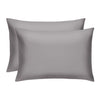News
Ice Bath Benefits: Everything You Need To Know
Published
June 07, 2023
Author
Nicholas Crusie

From viral reaction videos to professional athletes who swear by them, ice baths are all the rage right now. While plunging yourself in cold water may not sound like the most fun thing in the world, many claim that the health benefits are worth the shocking cold.
Are ice baths really worth it, though? Read on as we dive into the process and the benefits of bathing in cold water.
What Is an Ice Bath?
An ice bath is not merely a bath in cold water. It does actually involve ice and can be done at home in your own tub. Some gyms or professional training facilities have larger tubs or cold plunging pools they use for this purpose.
The average bath a person may take has a temperature between 90 and 105 degrees. An ice bath, however, is kept below 60 degrees Fahrenheit. Some say that the ideal water temperature for an ice bath is 53 degrees.
It is recommended that you take an ice bath right after intense workouts, when your muscles are still hot, your heart rate is elevated, and your body is still working hard to process the activity you just completed. When submerged in cold water, your blood vessels constrict and reduce in size.
As you get out of the water, the additional body temperature change rapidly re-opens your blood vessels, which flushes metabolic waste products. This helps deliver oxygen and nutrients to the muscles, which they desperately need after the workout. Cold water can also reduce inflammation, help reduce soreness, and speed up recovery time.
Are Ice Cold Baths Safe?
Is it safe to take the plunge into cold temperatures? If you follow the correct instructions, generally, the answer is yes. However, it is important to discuss your plans to try out ice baths with your doctor or other healthcare provider. They will be able to help you decide if an ice bath or other form of cryotherapy is right for you.
There are a few specific health conditions that could be exasperated by ice baths. If you have one of these conditions, it is recommended that you avoid cold water therapy.
- Heart Disease
- Diabetes
- High Blood Pressure
- Peripheral Neuropathy
- Poor Circulation
This is not an exhaustive list, so again, be sure to discuss with your doctor before attempting.
Don’t use ice baths as a replacement for proper medical treatment.
The goal of an ice bath is not to numb pain and it is dangerous to use it in this way. If you have an injury like a tendon or ligament tear, fracture, or sprain, don’t try to power through by using an ice bath.
Once you’re done in the ice cold bath, be sure to warm up again properly. Slowly but surely, don’t jump right into an extra hot shower. You can ease into taking an ice bath. If you’re unsure of it at first, try about 30 seconds, and then build up over time.
Cap your ice bath between 10 and 15 minutes, as any more than that isn’t beneficial anymore and could end up doing more harm than good. Ice baths may be uncomfortable, but they should not be painful.
If you experience pain or feel like the water is too cold, be sure to get out. Spending too long in water that is too cold could put you at risk for frostbite or other medical problems.
What Are the Benefits of Ice Baths?
Why are ice baths so popular? Is it all just hype, or does cold exposure actually benefit your health and recovery? These are valid questions, so we did some research so we could share the potential benefits of ice baths with you.
Ice Baths Help Soothe Muscle Soreness
There’s a reason why so many professional athletes, performers, and other highly active professionals swear by ice cold baths as part of muscle recovery. There’s nothing better after a hard training session than submerging your exhausted, sore muscles into ice cold water.
The process we discussed above of blood vesselconstriction is what helps reduce inflammation and may ease your sore muscles after strength training or another hard workout. It’s sweet post-exerciseactive recovery that can help you gear up for another training session tomorrow. This is definitely one of the top cold bath benefits.
Ice Baths Help Support Blood Circulation
When you enter the ice cold water, your body is in for a shock. It goes into survival mode and begins working overtime to get back to where it needs to be.
This causes your body to increase blood flow circulation. When you get out of the ice bath, freshly oxygenated blood is distributed throughout the body to places where it is needed.
Ice Baths Allow You to Maintain Immunity And Metabolism
Studies have shown that ice baths may in part help increase your immune system and help you metabolism. Exposure to cold water on a consistent basis can help avoid illnesses like the common cold, and may reduce the amount or severity of symptoms for other sicknesses.
Some may claim that cold water immersion can increase weight loss, but this has yet to be proven. It can be beneficial to your metabolism, but the weight loss benefits are debated.
Ice Baths Support Sleep Quality
If you’re having trouble falling asleep, a quick ice bath may help do the trick. While warm baths can aid in relaxation before bed, ice baths also come with their own benefits.
A five minute ice bath can spike your melatonin production, giving your body the signal that it’s time to for sleep. Once you’re done in the cold bath, keep your body temperature nice and cool by slipping into self-cooling sheets.
Ice Baths Can Soothe Stress
More research is being done to back up these claims, but many people report that ice baths and other forms of cold therapy have helped them overcome depression, anxiety, and other mental health struggles. Sometimes called the Wim Hof Method, many influencers swear by using cold water for mental health recovery.
There is some science to it, as cold water releases noradrenaline and cortisol and can increase dopamine. There will surely be more research released in the coming years to show whether or not this is a true benefit of ice baths.
Benefit of Cold Showers
Are ice baths the only way to do cold therapy and gain the health benefits? Not necessarily. Many of the benefits of ice baths can also be gained by cold showers. Plus, you can do it in the comfort of your own home and enjoy all your favorite shower supplies and cozy towels.
Taking a cold shower shares the benefits such as muscle recovery, alertness, and increased circulation. It is also a lot more convenient than a full ice bath! Another benefit of cold showers is the improvement of your hair, skin, and nails. The colder water is shown to be more beneficial to these systems.
Ice Cold Bath vs. Ice Cold Showers
As mentioned above, ice baths and cold showers share a lot of the same benefits. However, there are slight differences between the two. One main difference is the convenience.
Cold showers can also be safer for the average person as they can be done at home, while ice baths are better done with supervision from a professional. Ice baths are also better right after a workout or intense exercise, while a cold shower can be used anytime.
Overall, there aren’t huge differences between the two. It all comes down to what is the most convenient for you.
Conclusion
Now that you know the benefits of ice baths and cold showers, are you ready to take the plunge? When you incorporate these recovery practices after a hard workout or on a stressful day, you may see some wonderful benefits that will leave your body and mind feeling refreshed and ready to take on your next workout, life challenge, or good night’s sleep.
Try it for yourself and experience some great ice bath benefits.
Sources:
Can Ice Baths Ease My Sore Muscles? | Cleveland Clinic
Cold Water Therapy: Benefits of Cold Showers, Baths, Immersion Therapy | Healthline
What to Know About the Benefits of a Cold Shower vs. a Hot Shower | WebMD
Can Cold Water Plunges Really Reduce Anxiety and Depression? | The New York Times


















